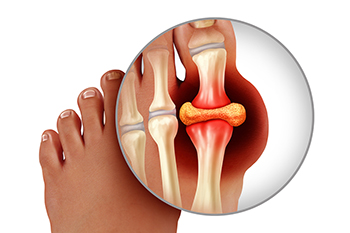
Gout is a type of arthritis characterized by sudden and severe pain, redness, and swelling in the joints, often affecting the big toe. This condition occurs when there is a buildup in the blood of uric acid, which forms sharp crystals in the joints. The body’s inability to properly eliminate uric acid is the primary cause of this buildup. Several risk factors increase the likelihood of developing gout, including obesity, excessive alcohol consumption, a diet high in purines, found in red meat and seafood, and certain medical conditions like high blood pressure and diabetes. Gout can also be genetic, with a family history increasing the risk. The symptoms of gout typically begin with intense pain in a single joint, often at night, accompanied by swelling and a feeling of warmth in the affected area. If left untreated, gout can gradually lead to joint damage and chronic pain. If you have pain in your big toe, or experience any of the above symptoms, it is suggested that you promptly contact a podiatrist who can provide a proper diagnosis and offer effective relief solutions.
Gout is a foot condition that requires certain treatment and care. If you are seeking treatment, contact Bruce Smit, DPM from Frankfort Foot & Ankle Clinic. Our doctor will treat your foot and ankle needs.
What Is Gout?
Gout is a type of arthritis caused by a buildup of uric acid in the bloodstream. It often develops in the foot, especially the big toe area, although it can manifest in other parts of the body as well. Gout can make walking and standing very painful and is especially common in diabetics and the obese.
People typically get gout because of a poor diet. Genetic predisposition is also a factor. The children of parents who have had gout frequently have a chance of developing it themselves.
Gout can easily be identified by redness and inflammation of the big toe and the surrounding areas of the foot. Other symptoms include extreme fatigue, joint pain, and running high fevers. Sometimes corticosteroid drugs can be prescribed to treat gout, but the best way to combat this disease is to get more exercise and eat a better diet.
If you have any questions please feel free to contact our office located in Frankfort, IL . We offer the newest diagnostic and treatment technologies for all your foot and ankle needs.
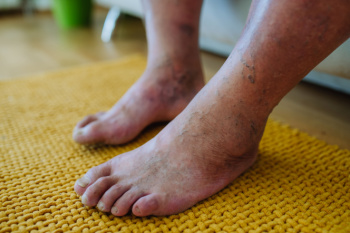
Foot care often gets overlooked with everything else diabetic patients manage, but it is vital. High blood sugar can damage nerves and reduce circulation, making feet prone to injury, infections, and slow healing. This can lead to serious complications like ulcers, or, in severe cases, limb loss. Daily foot checks are essential. Look for cuts, blisters, redness, or swelling. Proper shoes and socks matter, too. Choose breathable, cushioned options without seams to prevent friction. Keep toenails trimmed carefully, and never ignore any signs of infection or persistent pain. Controlling blood sugar levels plays a key role in maintaining foot health. If you have diabetes, it is strongly suggested that you regularly visit a podiatrist to ensure foot issues are caught early and managed effectively. A podiatrist can also recommend specialized footwear or treatments to keep your feet safe.
Diabetic foot care is important in preventing foot ailments such as ulcers. If you are suffering from diabetes or have any other concerns about your feet, contact Bruce Smit, DPM from Frankfort Foot & Ankle Clinic. Our doctor can provide the care you need to keep you pain-free and on your feet.
Diabetic Foot Care
Diabetes affects millions of people every year. The condition can damage blood vessels in many parts of the body, especially the feet. Because of this, taking care of your feet is essential if you have diabetes, and having a podiatrist help monitor your foot health is highly recommended.
The Importance of Caring for Your Feet
Patients with diabetes should have their doctor monitor their blood levels, as blood sugar levels play such a huge role in diabetic care. Monitoring these levels on a regular basis is highly advised.
It is always best to inform your healthcare professional of any concerns you may have regarding your feet, especially for diabetic patients. Early treatment and routine foot examinations are keys to maintaining proper health, especially because severe complications can arise if proper treatment is not applied.
If you have any questions please feel free to contact our office located in Frankfort, IL . We offer the newest diagnostic and treatment technologies for all your foot and ankle needs.
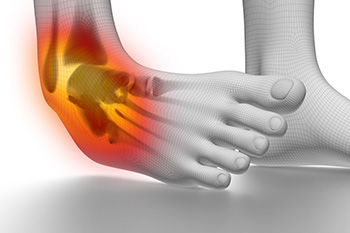
Ankle sprains occur when the ligaments supporting this complex joint are stretched or torn. Ankle sprains are classified into three grades, based on severity. Grade 1 sprains involve mild stretching of the ligaments, causing slight pain and swelling. Grade 2 sprains are moderate, with partial tearing of the ligaments, leading to noticeable swelling, bruising, and difficulty walking. Grade 3 sprains are severe, involving complete ligament tears, significant swelling, instability, and an inability to bear weight. Risk factors include improper footwear, uneven surfaces, and activities requiring sudden movements. A podiatrist can assess the extent of the sprain through a detailed exam and use imaging tests to rule out fractures. Treatment options include braces or casts to stabilize the ankle and allow proper healing, with a focus on preventing chronic issues like instability. In cases of a Grade 3 sprain, surgery may be required to restore joint function. If you have sprained an ankle, it is suggested that you make an appointment with a podiatrist for an exam and treatment options.
Ankle sprains are common but need immediate attention. If you need your feet checked, contact Bruce Smit, DPM from Frankfort Foot & Ankle Clinic. Our doctor can provide the care you need to keep you pain-free and on your feet.
How Does an Ankle Sprain Occur?
Ankle sprains take place when the ligaments in your ankle are torn or stretched beyond their limits. There are multiple ways that the ankle can become injured, including twisting or rolling over onto your ankle, putting undue stress on it, or causing trauma to the ankle itself.
What Are the Symptoms?
Preventing a Sprain
Treatment of a Sprain
Treatment of a sprain depends on the severity. Many times, people are told to rest and remain off their feet completely, while others are given an air cast. If the sprain is very severe, surgery may be required.
If you have suffered an ankle sprain previously, you may want to consider additional support such as a brace and regular exercises to strengthen the ankle.
If you have any questions please feel free to contact our office located in Frankfort, IL . We offer the newest diagnostic and treatment technologies for all your foot and ankle needs.

Pickleball, a paddle sport blending elements of tennis, badminton, and ping-pong is enjoyed by players of all ages. Its quirky name is said to have originated from a founder's dog or a rowing term referring to mixed teams. While the game offers excellent physical activity and sharpens mental focus, picklers must prioritize injury prevention. The fast-paced movements and quick turns in pickleball put stress on the ankles and lower legs, increasing the risk of sprains, strains, and overuse injuries. Without proper preparation, even experienced players can face setbacks. Warmup routines, such as calf stretches, ankle rolls, and light cardio, are important to loosen muscles and improve flexibility. If foot or ankle pain arises after play, it is suggested that you consult a podiatrist who can ensure you stay active and injury-free for future matches.
Sports related foot and ankle injuries require proper treatment before players can go back to their regular routines. For more information, contact Bruce Smit, DPM of Frankfort Foot & Ankle Clinic. Our doctor can provide the care you need to keep you pain-free and on your feet.
Sports Related Foot and Ankle Injuries
Foot and ankle injuries are a common occurrence when it comes to athletes of any sport. While many athletes dismiss the initial aches and pains, the truth is that ignoring potential foot and ankle injuries can lead to serious problems. As athletes continue to place pressure and strain the area further, a mild injury can turn into something as serious as a rupture and may lead to a permanent disability. There are many factors that contribute to sports related foot and ankle injuries, which include failure to warm up properly, not providing support or wearing bad footwear. Common injuries and conditions athletes face, including:
Sports related injuries are commonly treated using the RICE method. This includes rest, applying ice to the injured area, compression and elevating the ankle. More serious sprains and injuries may require surgery, which could include arthroscopic and reconstructive surgery. Rehabilitation and therapy may also be required in order to get any recovering athlete to become fully functional again. Any unusual aches and pains an athlete sustains must be evaluated by a licensed, reputable medical professional.
If you have any questions please feel free to contact our office located in Frankfort, IL . We offer the newest diagnostic and treatment technologies for all your foot and ankle needs.
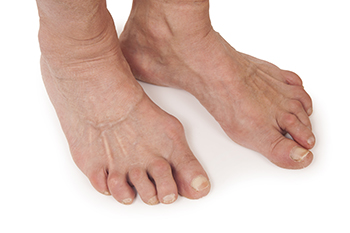
Rheumatoid arthritis, or RA, is an autoimmune disorder that causes chronic inflammation in the joints, leading to pain, swelling, and stiffness. The condition occurs when the immune system mistakenly attacks healthy joint tissues. RA can cause significant discomfort, with common symptoms including pain, redness, and swelling, especially in the toes and the balls of the feet. Over time, joint damage can lead to deformities, making walking and standing difficult. Several types of RA, ranging from mild to severe, each affect different joints. Risk factors for developing rheumatoid arthritis include family history, smoking, and gender, with women more likely to develop RA. Additionally, certain genetic markers may increase the likelihood of developing this condition. If your feet show signs of RA, it is strongly suggested that you consult a podiatrist who can help you monitor your foot health.
Because RA affects more than just your joints, including the joints in your feet and ankles, it is important to seek early diagnosis from your podiatrist if you feel like the pain in your feet might be caused by RA. For more information, contact Bruce Smit, DPM of Frankfort Foot & Ankle Clinic. Our doctor will assist you with all of your podiatric concerns.
What Is Rheumatoid Arthritis?
Rheumatoid Arthritis (RA) is an autoimmune disorder in which the body’s own immune system attacks the membranes surrounding the joints. Inflammation of the lining and eventually the destruction of the joint’s cartilage and bone occur, causing severe pain and immobility.
Rheumatoid Arthritis of the Feet
Although RA usually attacks multiple bones and joints throughout the entire body, almost 90 percent of cases result in pain in the foot or ankle area.
Symptoms
Diagnosis
Quick diagnosis of RA in the feet is important so that the podiatrist can treat the area effectively. Your doctor will ask you about your medical history, occupation, and lifestyle to determine the origin of the condition. Rheumatoid Factor tests help to determine if someone is affected by the disease.
If you have any questions please feel free to contact our office located in Frankfort, IL . We offer the newest diagnostic and treatment technologies for all your foot and ankle needs.
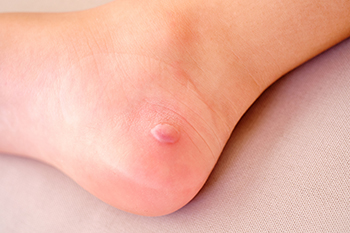
Blisters on the feet are often caused by friction, pressure, or irritation. Friction blisters, the most frequent type, typically form when ill-fitting shoes rub against the skin, leading to the buildup of fluid between layers of skin. Symptoms include redness, swelling, and the formation of a small, raised bubble filled with clear fluid. Blisters can be painful, especially when walking or standing. Common causes of blisters include new shoes, prolonged walking, or activities that cause repetitive rubbing, such as running. Excessive moisture or sweaty feet can also contribute to blister formation. A podiatrist can help by assessing the severity of the blister and offering safe and sterile wound care. If a blister is infected or causing persistent pain, this type of doctor may recommend drainage, dressing techniques, or the use of specialized footwear to prevent further irritation. Custom orthotics or padding may also be suggested to reduce friction. If you are dealing with this issue, it is suggested that you schedule an appointment with a podiatrist.
Blisters are prone to making everyday activities extremely uncomfortable. If your feet are hurting, contact Bruce Smit, DPM of Frankfort Foot & Ankle Clinic. Our doctor can provide the care you need to keep you pain-free and on your feet.
Foot Blisters
Foot blisters develop as a result of constantly wearing tight or ill-fitting footwear. This happens due to the constant rubbing from the shoe, which can often lead to pain.
What Are Foot Blisters?
A foot blister is a small fluid-filled pocket that forms on the upper-most layer of the skin. Blisters are filled with clear fluid and can lead to blood drainage or pus if the area becomes infected.
How Do Blisters Form?
Blisters on the feet are often the result of constant friction of skin and material, usually by shoe rubbing. Walking in sandals, boots, or shoes that don’t fit properly for long periods of time can result in a blister. Having consistent foot moisture and humidity can easily lead to blister formation.
Prevention & Treatment
It is important to properly care for the affected area in order to prevent infection and ease the pain. Do not lance the blister and use a Band-Aid to provide pain relief. Also, be sure to keep your feet dry and wear proper fitting shoes. If you see blood or pus in a blister, seek assistance from a podiatrist.
If you have any questions, please feel free to contact our office located in Frankfort, IL . We offer the newest diagnostic and treatment technologies for all your foot care needs.
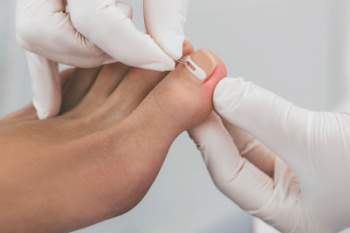
Ingrown toenails occur when the edges of a toenail grow into the surrounding skin, causing pain, redness, and swelling. Certain activities, like ballet or football, can increase the risk of developing ingrown toenails. In ballet, the pressure from pointe work can cause the toenails to compress against the shoe, while football players often wear tight cleats that crowd the toes. These tight shoes, combined with repetitive movements, can lead to nail damage and ingrown toenails. Other causes include improper nail trimming such as cutting them too short or rounding the edges, injury, or genetic factors that make the toenails more prone to growing into the skin. If left untreated, ingrown toenails can become infected and lead to more serious complications. Visiting a podiatrist is key to proper diagnosis and treatment. This type of doctor can safely remove the ingrown nail, prevent or treat infection, and offer advice on proper nail care and footwear to avoid recurrence. If you have an ingrown toenail, it is suggested that you schedule an appointment with a podiatrist.
Ingrown toenails can become painful if they are not treated properly. For more information about ingrown toenails, contact Bruce Smit, DPM of Frankfort Foot & Ankle Clinic. Our doctor can provide the care you need to keep you pain-free and on your feet.
Ingrown Toenails
Ingrown toenails occur when a toenail grows sideways into the bed of the nail, causing pain, swelling, and possibly infection.
Causes
Prevention
Because ingrown toenails are not something found outside of shoe-wearing cultures, going barefoot as often as possible will decrease the likeliness of developing ingrown toenails. Wearing proper fitting shoes and using proper cutting techniques will also help decrease your risk of developing ingrown toenails.
Treatment
Ingrown toenails are a very treatable foot condition. In minor cases, soaking the affected area in salt or antibacterial soaps will not only help with the ingrown nail itself, but also help prevent any infections from occurring. In more severe cases, surgery is an option. In either case, speaking to your podiatrist about this condition will help you get a better understanding of specific treatment options that are right for you.
If you have any questions please feel free to contact our office located in Frankfort, IL . We offer the newest diagnostic and treatment technologies for all your foot and ankle needs.

Pickleball’s fast-paced nature and quick movements place significant physical demands on your body, making post-game recovery essential. After playing, a proper cool-down routine helps prevent stiffness and soreness. Light stretches targeting your calves, hamstrings, and ankles can improve flexibility and reduce muscle tension. A short, easy walk also aids circulation, helping your body recover more efficiently. Staying hydrated is critical, as sweating during gameplay can lead to fluid loss that affects muscle function and recovery. Allow your body time to rest, giving overworked muscles a chance to repair and rebuild. Persistent foot or ankle pain should never be ignored. If you are experiencing this, it is suggested that you consult a podiatrist and address any foot or ankle injuries promptly.
If you have any concerns about your feet, contact Bruce Smit, DPM from Frankfort Foot & Ankle Clinic. Our doctor can provide the care you need to keep you pain-free and on your feet.
Biomechanics in Podiatry
Podiatric biomechanics is a particular sector of specialty podiatry with licensed practitioners who are trained to diagnose and treat conditions affecting the foot, ankle and lower leg. Biomechanics deals with the forces that act against the body, causing an interference with the biological structures. It focuses on the movement of the ankle, the foot and the forces that interact with them.
A History of Biomechanics
Modern technological improvements are based on past theories and therapeutic processes that provide a better understanding of podiatric concepts for biomechanics. Computers can provide accurate information about the forces and patterns of the feet and lower legs.
Understanding biomechanics of the feet can help improve and eliminate pain, stopping further stress to the foot.
If you have any questions please feel free to contact our office located in Frankfort, IL . We offer the newest diagnostic and treatment technologies for all your foot and ankle needs.